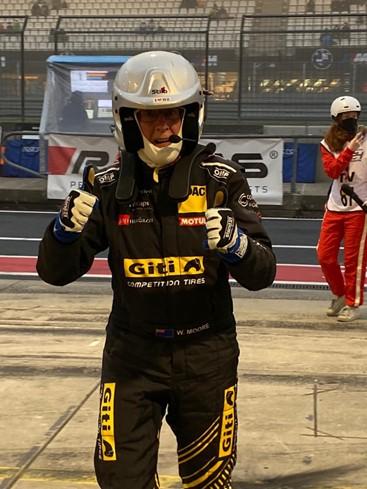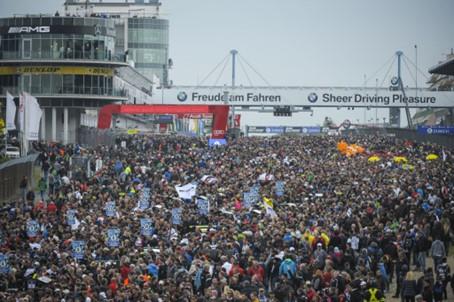New Zealand endurance race car driver Wayne Moore from Paekākāriki has faced a series of trials this year before the grid for 51st ADAC TotalEnergies Nürburgring 24 Hour Race has even been announced.
Moore is planning a return to Germany for his 29th year driving this endurance event on the legendary Nordschleife race track.
His biggest pre-race challenge is not yet having the required German licence to drive due to a series of frustrations with technology.
Each of the 800 drivers in the race which attracts competitors from 30 nationalities to pilot up to 200 cars must complete a series of e-learning training modules before the licence is issued. And for Moore this year the electronic portal is still firmly locked. “The DMSB licencing office has been very helpful in trying to circumvent the issue and I’m hopeful we’ll get there before race start on Saturday 20th May. It’s just unsettling not already having the card in my wallet” says Moore.

Also unsettling is the car Moore will drive this year as the BMW 328i he drove in 2022 in class V2T for production 2-litre turbo cars was subsequently destroyed in a crash. “WS Racing by GITI Tires have been building a replacement BMW330 which must still be in development as it did not front for the 24 Hour Qualifying Race during April.” Moore adds; “It’s no big deal for smaller cars missing that event as it is more a shake down for us. The front runners can secure race entry with a successful result although there were many missing this year due to date clashes with other racing championships.”
Following two crowd-free years due to COVID restrictions 230,000 fans returned to camp around the 25.3km race track last year and Moore says the atmosphere was very special as fans had been starved of their annual ‘petrol head’ adrenalin fix. They are an especial community and often families camp on the same hillside site year after year.
Nana and Granddad will be relaxing if you can with 110 decibel cars racing past only metres away, while parents will be watching the race and the kids who often have a paddling pool, sand pit and toys. Empty beer cans are stacked sky high on some sites and there is a genuine comradery with fans sharing food and drinks whichever manufacturer or driver they support.
Early-bird fans camp for an entire week of motorsport activities and you can spot their little convoys on the autobahns. A mobile home, followed by a vehicle towing a trailer loaded with firewood and a further vehicle decorated with race posters and decals. And then there are the tyre company convoys with up to twenty semi-trailers fully loaded for each of the major brands. That’s all aside of the team transporters which take a full day to be precisely parked in the 10-hectare pit paddock. The Nürburgring 24 Hour is a very big event.

The purpose-built Nordschleife race track was opened in 1927 and camping fans often have strong connection with the tarmac winding through the undulating Eifel Mountain forests. Pit access is included in the price of an event ticket and there is regular crowd congestion in the roadways between the transporters and marques of the teams.
The carnival atmosphere with such numbers is eclectic and car manufacturers and many other companies build substantial promotions for race week. Fan Alleys also provide an array of model cars, motoring memorabilia, clothing, food and driving simulations.
Add to this the VIP Lounges above the pit garages and grandstands with some manufacturers rumoured to entertain 400 guests a day during the event. The logistics of these activities are only over shadowed by those on the track with hundreds of marshals at line of site points around the entire circuit, providing race logistics and crewing fleets of intervention and emergency vehicles.
One lap of the Nürburgring is 25.3km and it is not feasible to use safety cars on such a lengthy circuit. Race incidents will often trigger a localised 60 kilometre per hour maximum speed limit through a system called Code 60. Pit lane speed limit is also 60 km/hr so drivers engage their speed limiter to ensure compliance and respect the safety of those working on the track. Moore says it is not uncommon to drive on the grass verge to safely pass an incident.
Current regulations restrict a driver from driving for more than three hours without a two hour break and Moore has been invited to join Hamburg drivers Matthias Möller and Fabian Pirrone again this year with a fourth driver to be confirmed.
“Some years we’ve driven with three. Do the maths and that’s good with a total of eight hours each although it’s also quite tiring as you need to be on standby when next in the car.” Moore continues “I’ve often been quite humbled when my co-drivers have invited me to take an unfair proportion of the driving time due to the distance from home.
And I’m always very appreciative and of course accept.”
Other than a handful of German nationals no race car driver in the world has competed in this event more often than Moore which is another influence to overcome the pre-race challenges currently being faced. Fans stay at Moore’s B&B pension before the 24-hour event to spend time with the Kiwi which he says is also very humbling.
“There are only three or four driver’s names on a race car window and many dozens if not hundreds of other folks supporting and ‘riding in the car’ and I’ve always respected that” says Moore.
The race has a unique flair as it attracts ambitious amateurs and professional drivers employed by factory teams regularly including young Kiwis. It’s rumoured these teams can spend €1m over race weekend when they run three cars and entertain thousands of existing and potential customers. Moore raced for a Volkswagen factory-supported team for 17 years and says their budget was miniscule compared with today’s figures.
The motorsport adage of ‘win on Sunday, sell on Monday’ runs true in the Eifel Mountains with fierce competition at the front of the field. “It’s not uncommon to see race cars stuck in a gravel trap after leaving the circuit on turn one at the very start of the race in the intense battle to dominate television coverage at the front of the field” says Moore.
“It’s all about being there at the finish for us and right now my focus is being there at the start.”



Comments